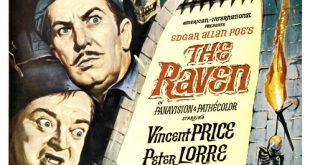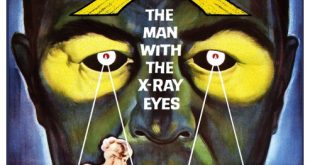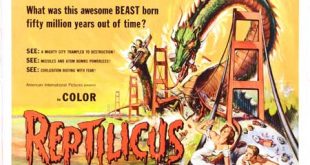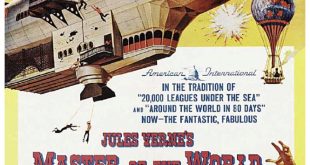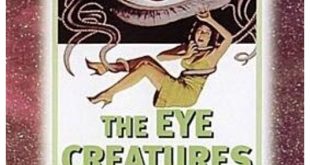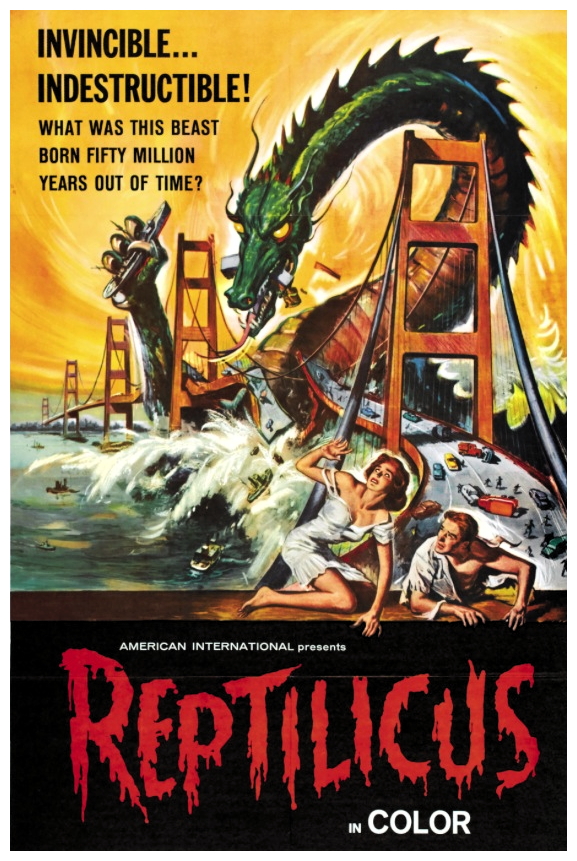
SYNOPSIS:
“Copper miners in the tundras of Lapland discover a frozen piece of reptilian tail belonging to some unknown prehistoric creature. Taking the specimen to an aquarium in Copenhagen, Professor Martens gets more than he bargained for when the tail regenerates into a giant, acid spitting monster that terrorises the country. The Danish military, led by UN-appointed American general Mark Grayson attempts to hunt down the monster and destroy it, only to realise that blowing the thing up will create hundreds of little creatures.” (courtesy IMDB)
REVIEW:
January 1961: editor Forrest J. Ackerman has just completed the tenth issue of Famous Monsters Of Filmland magazine in time to deliver an exciting bulletin about a new Swedish monster movie entitled Reptilicus (1961): “The body of Reptilicus is long and slender with a long pliable tail, the creature is covered with huge overlapping scales. Big tufts of black hair stick out from between the scales. The forelegs are grotesquely small but with long sharp claws. From the beast’s sides sprouts a pair of tapering, bat-like wings. The head resembles a cross between that of a rattlesnake and a vampire bat. Huge slit-pupilled eyes gleam coldly and cruelly, venom-dripping fangs menace from the slimy gaping maw…” What my old friend Forry failed to say was that Reptilicus, contrary to this tasty piece of Hollywood hype, was actually a direct descendant of the Flub-A-Dub, a ridiculous marionette seen on The Howdy Doody Show (1948) as Doodyville’s resident dragon, supposedly made up of eight different animals.
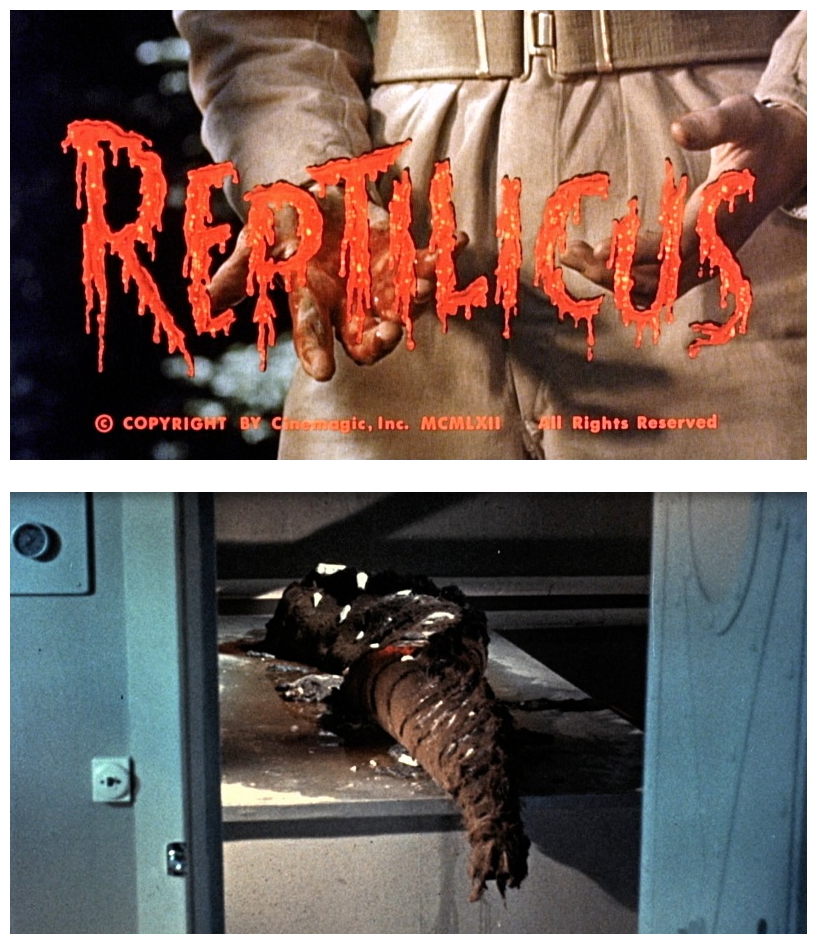
Take a moment to reflect on the colourful, moronic slew of Japanese giant monster movies during the sixties, replete with their cretinous plots, tacky effects and atrocious dubbing, and then consider Reptilicus, which has the dubious distinction of being in a class all by itself as Denmark’s first and only giant monster movie. Reptilicus was the brain-fart…I mean, brainchild of writer-director Ib Melchior, born in Denmark in 1917, who lived a frankly amazing life before passing away just a few years ago in 2015. Highly decorated during World War II (supplying evidence that led to the Nuremburg trials), he went on to become an award-winning documentarian, author, filmmaker, screenwriter and playwright. Novels include Hitler’s Werewolves (1972), The Tombstone Cipher (1983) and Code Name Grand Guignol (1987). Stage productions include Hour Of Vengeance (1982) based on the ancient Viking tale of Amled, which was ripped off…I mean, the original inspiration for William Shakespeare‘s Hamlet.
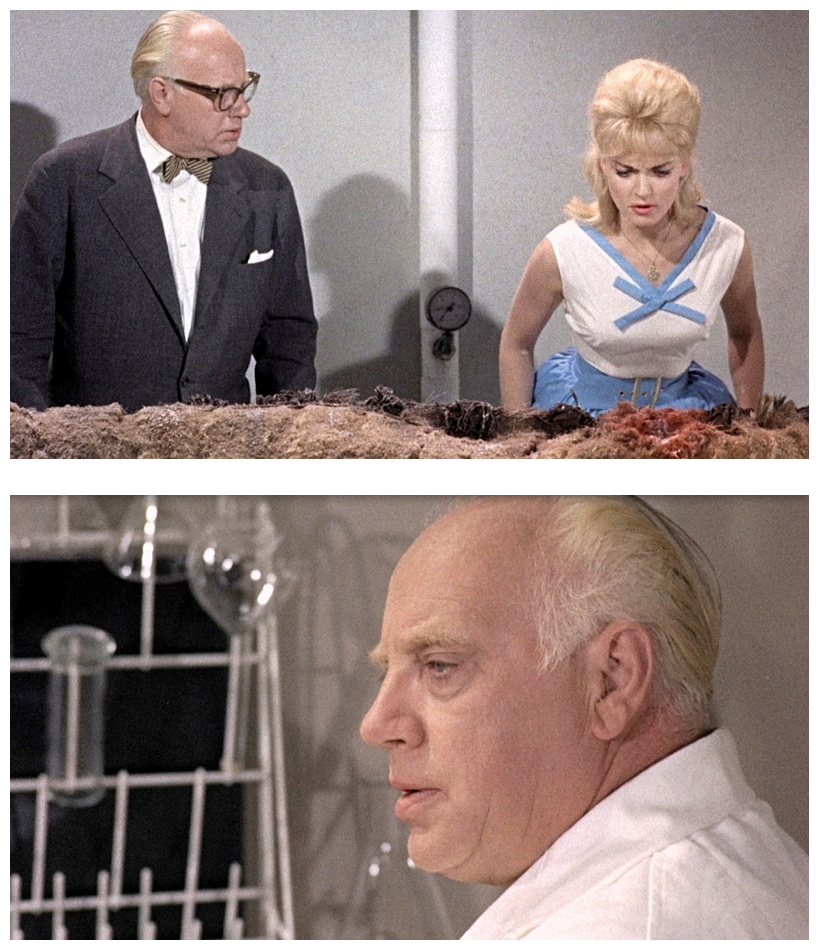
Teleplays include The Outer Limits episode The Premonition (1965), and his most high-profile film credit was as co-writer of Robinson Crusoe On Mars (1964). He also wrote screenplays for Journey To The Seventh Planet (1962) and the English language version of Planet Of The Vampires (1965). Sadly (or fortunately, depending on your point of view), Melchior directed only two movies in his lifetime: The Time Travellers (1964) and The Angry Red Planet (1959). Inspired by the original Godzilla (1954) and The Giant Behemoth (1959), Melchior decided to steal…I mean, utilise the plots of both movies and concoct Reptilicus, with the notion that New York, London and Tokyo had endured its share of mayhem, and that it was now high-time for Stockholm to do battle with a giant ‘IT’. The story begins with a drilling operation scooping up a slimy cache of living tissue from the bowels of the earth, and trucks it over to the local university where a venerable scientist (Asbjørn Andersen) declares it to be a part of creature’s tail.
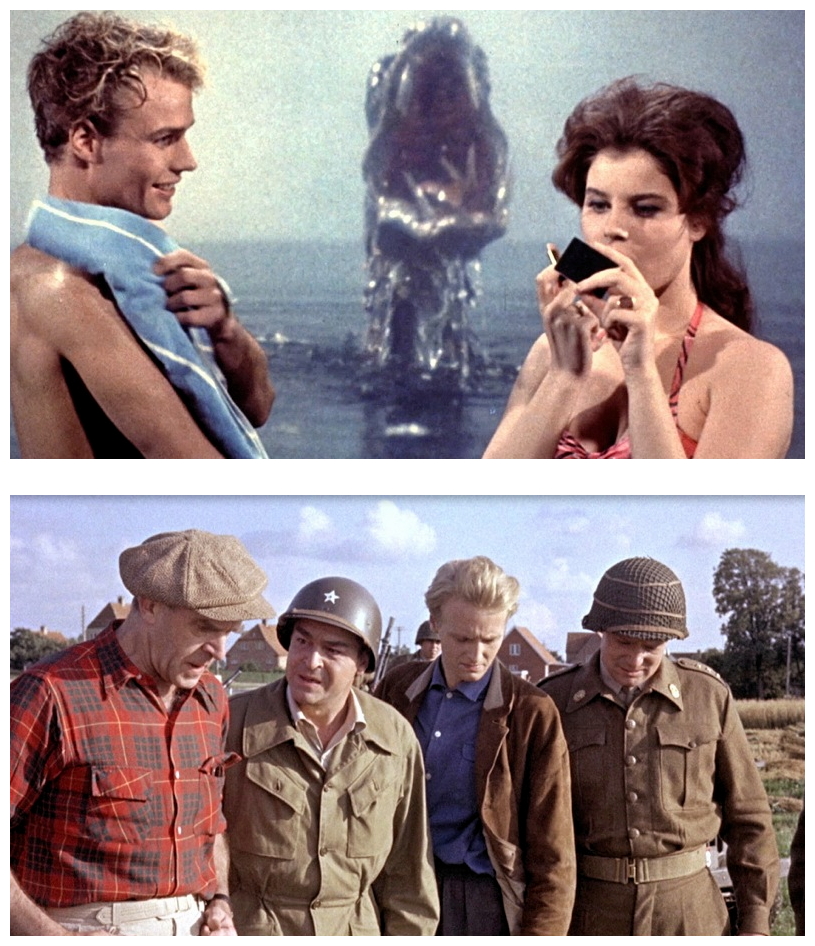
When the flesh doubles its size overnight in a fish-tank, the scientist concludes that it regenerates like a starfish. In no time at all, the piece of tail outgrows its two-by-four aquarium, escapes to slither back into the sea, capsize a freighter ship, and heads for town because there are people there to step on. When the military runs out of ammunition, they erect power lines along the Baltic Sea which only makes the monster cranky. With mankind quivering in its boots, the General (Carl Ottosen) stumbles on the highly original idea of spiking the tip of a torpedo with a knockout drug. Reptilicus gets shelled underwater and is promptly converted into a Swedish meatball. Just when you thought it was safe to bask in the Baltic, the dismembered claw of Reptilicus does a curtain-call and sinks off in the corner of the screen. “Can the whole world can wake up and live again?”
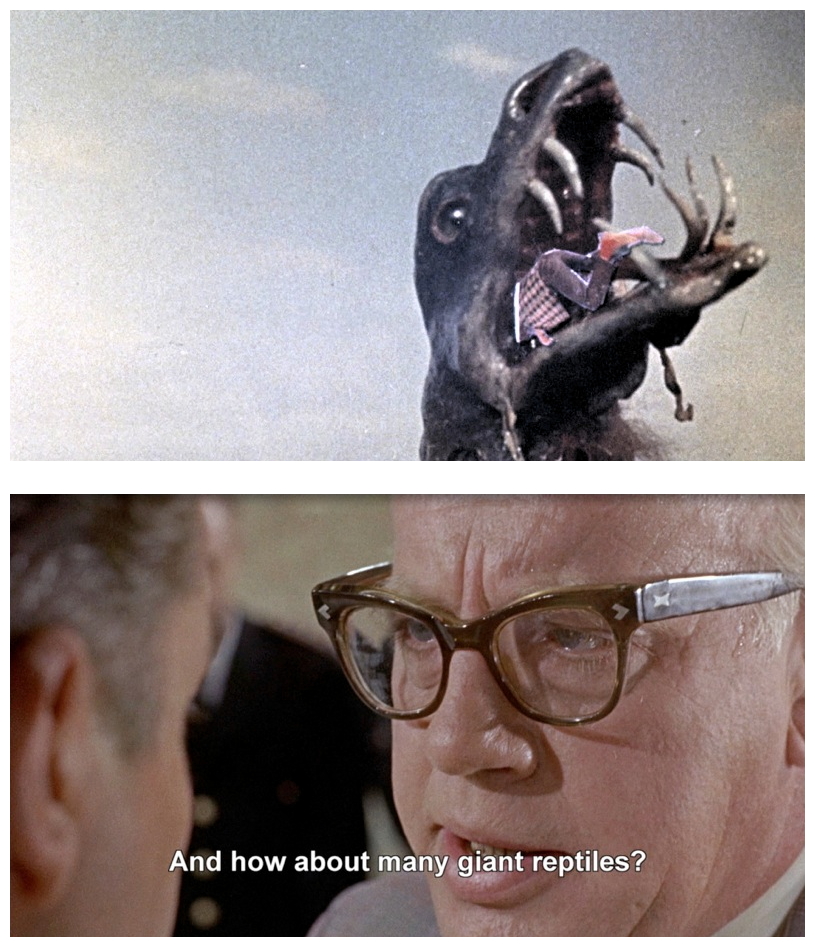
Like The Giant Claw (1957), The Blob (1958) and a dozen other films of the era, the movie finishes with a question mark, implying the threat of a sequel of which we have been mercifully spared. Aside from one of the most ridiculous monsters ever to waltz down a busy intersection, highlights include cardboard miniatures of Stockholm that make Tokyo’s paper cities look like Greg Jein masterpieces. There was barely enough budget to cover split-screen shots of humans fleeing in terror from the beast, resulting in unbridled hilarity as live-action cuts directly to shots of the prehistoric puppet ambling about wildly on a tabletop set. Melchior personally paid for one terrible blue-screen shot of the monster swallowing a farmer (played by Ib’s 12-year-old son Dirk Melchior) which is about as convincing as Donald Trump‘s hair. If eating people wasn’t enough, Reptilicus barfs up bright green cartoon-animated vomit on pedestrians in lieu of the usual Godzilla-style fire breath, which indeed makes for a very ‘special’ effect.

We’ve seen cheesy monsters on the loose before, though perhaps not quite as cheesy as this one. We’ve encountered the Japanese art of overdubbing, where feisty Oriental mouths twitch spasmodically in their native tongue and finish a sentence while the English-language loop trails behind. What puts Reptilicus on its own special pedestal is precisely that – the dubbing. Two versions were filmed: One was the original Danish version; and the other was filmed with the same actors speaking English. All the actors were in both versions with one exception – Bodil Miller was unable to speak English, and was replaced by Marlies Behrens. American International Pictures used the English version for the US release, but not before some major editing and dubbing over the Danish actors with new voices. The end result drones on so badly with so little emotion, it makes Captain Scarlet look like a Robert Altman film.
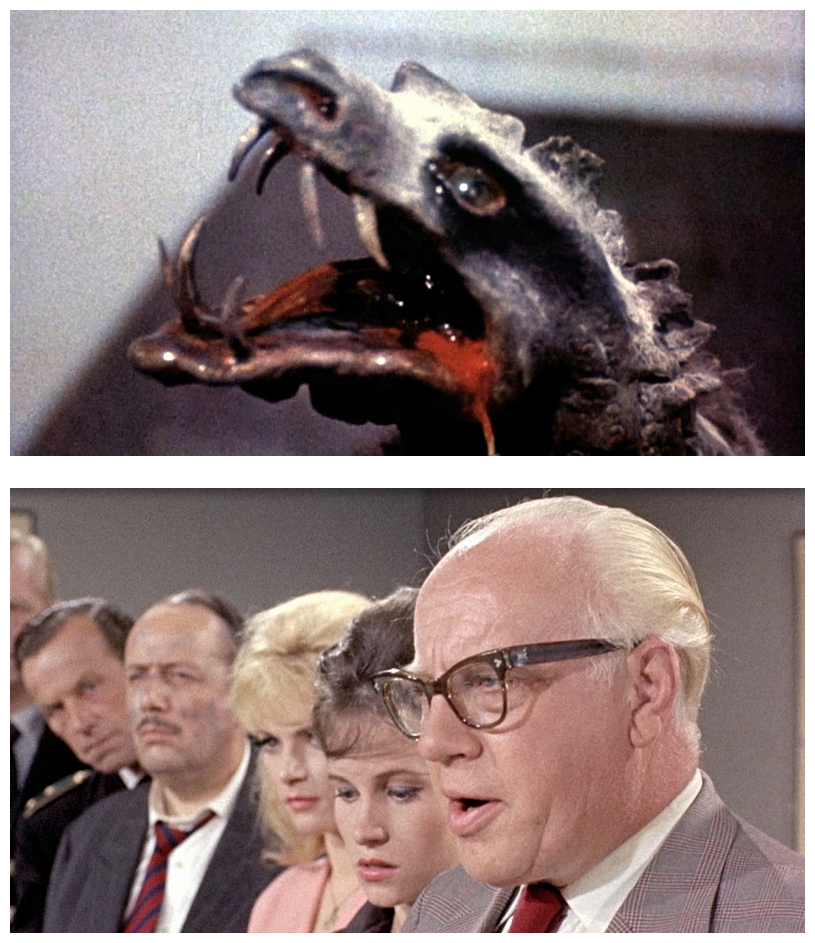
This is particularly evident in the case of Carl Ottosen as General Grayson, the same baritone who appeared in Journey To The Seventh Planet (1962). His robot-like ‘macho’ delivery of Melchior’s meandering script will dumfound you. Experiencing Reptilicus for the first time is like experiencing a new kind of drug. The dialogue is so contrived, derivative and stilted, the effect is utterly hypnotic. Watching Reptilicus dangle and regurgitate is tantamount to a momentary rush – just when you think you’re coming out of it, the dialogue resumes and you sink deeper into an induced lethargy. I defy anyone to subject themselves to the first thirty minutes of Reptilicus and not walk out of the room feeling like they’ve been shot with novocaine and, if you really want to go limp, watch the whole movie from head to tail – it beats the hell out of standard barbiturates. That being said, I forgive Ib Melchior, a white-bearded, bespectacled, gentle soul, for he knew not what he was doing.
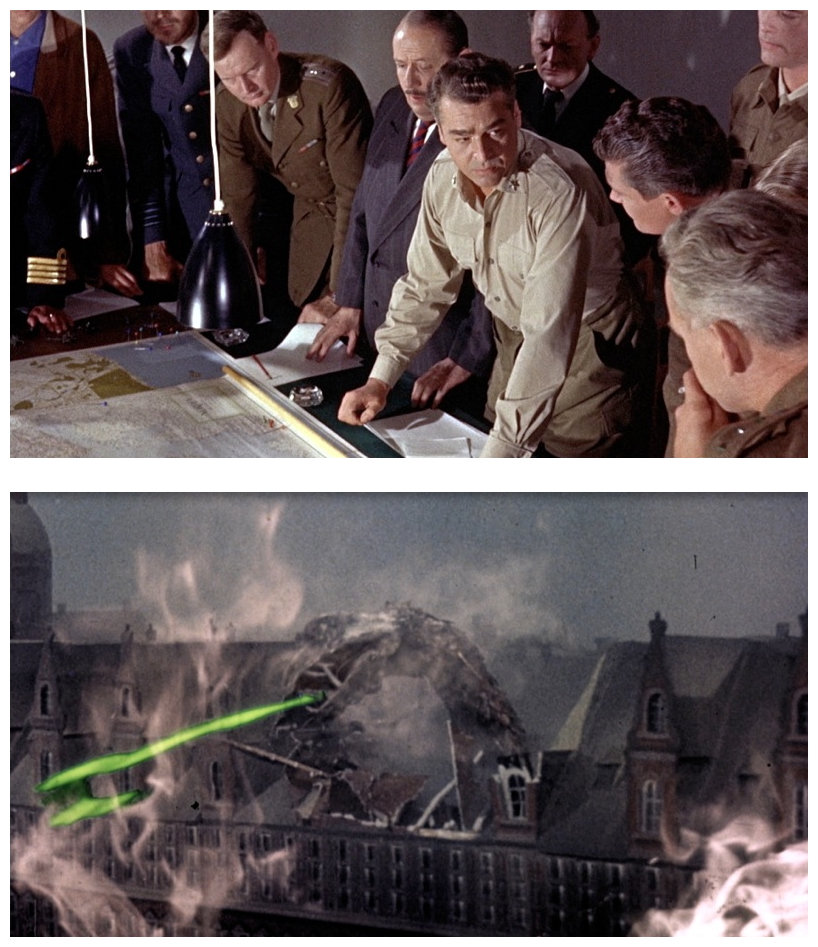
After Reptilicus, Melchior created an outline for a television series called Space Family Robinson, which later became a Gold Key comic. Irwin Allen, producer of the popular television show Lost In Space, had apparently utilised this material without permission or credit to the original source. Come the mid-seventies Rollerball (1975) was released, and independent producer Roger Corman was looking for a property in order to jump on the ‘violent sports’ bandwagon. Purchasing Melchior’s short story The Racer, Corman made the cult classic Death Race 2000 (1975) directed by Paul Bartel starring David Carradine and Sylvester Stallone, which was remade as Death Race (2008) starring Jason Statham, directed by Paul WS Anderson and produced by Tom Cruise, but that’s another story for another time. I’ll ask you to please join me next week when I shall discuss another for Horror News. Until then, good night and remember, as my old friend Bela Lugosi would say, “Bevare! Bevare of the big, green dragon that sits on your doorstep – and the gifts it leaves on your lawn.” Toodles!
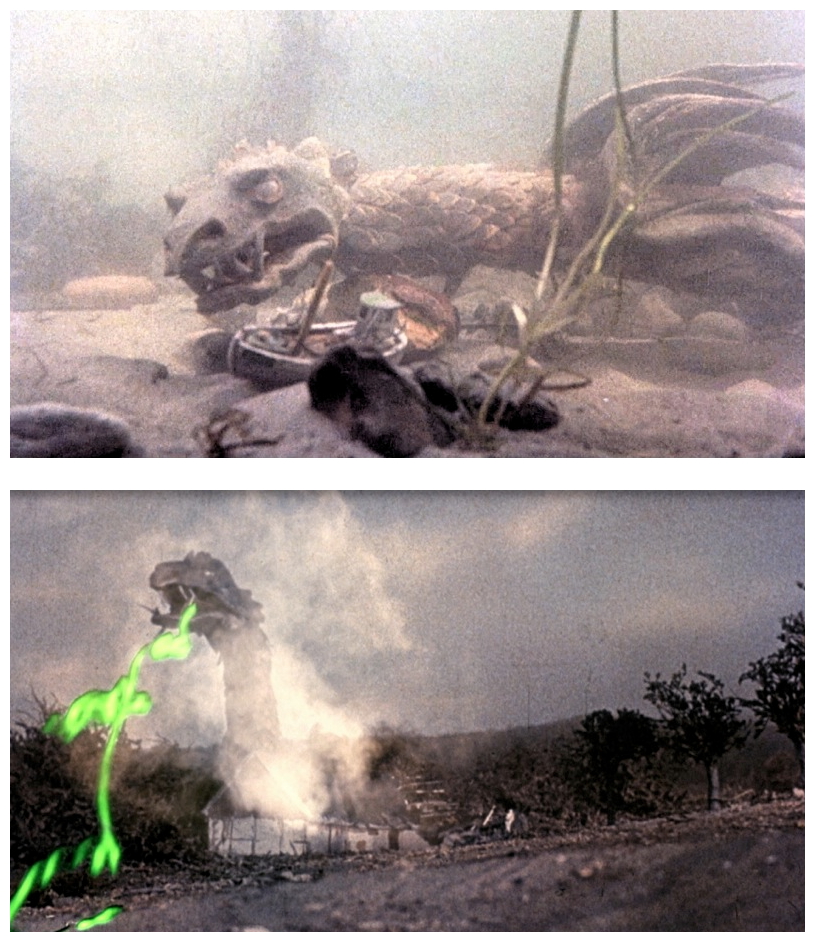
Reptilicus (1961)
 Horror News | HNN Official Site | Horror Movies,Trailers, Reviews
Horror News | HNN Official Site | Horror Movies,Trailers, Reviews
